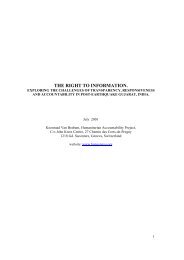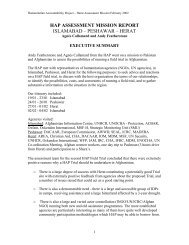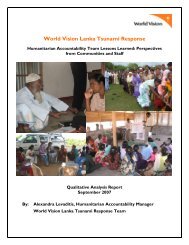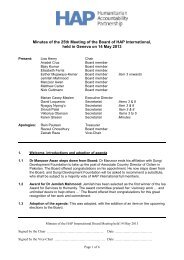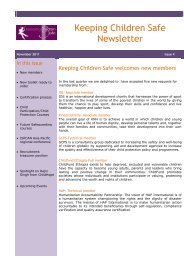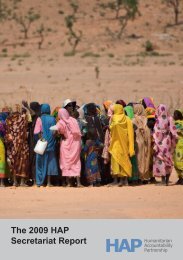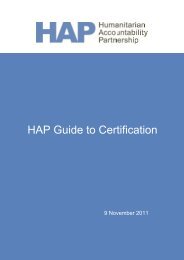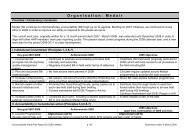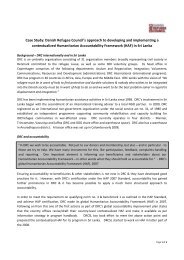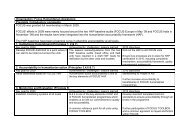Chapter Four - HAP International
Chapter Four - HAP International
Chapter Four - HAP International
Create successful ePaper yourself
Turn your PDF publications into a flip-book with our unique Google optimized e-Paper software.
THE 2008 HUMANITARIAN ACCOUNTABILITY REPORT<br />
19. Tearfund UK<br />
sharing lessons learnt across emergency<br />
responses.<br />
Quality Standards, with consultation most effective in<br />
new emergency situations.<br />
• Learning reviews and evaluation recommendations<br />
were collated into key learning documents.<br />
and develop partner capacities, and for<br />
monitoring and evaluation.<br />
Case Study Example: Good practice in humanitarian accountability and quality management – Summary version<br />
Between 2005-2008, Tearfund responded operationally to the post-conflict situation in Liberia, with watsan, public health, food security and community<br />
development projects in 4 counties, reaching over 100,000 beneficiaries. The Liberia programme was selected for the <strong>HAP</strong> field audit as part of the<br />
certification process.<br />
What went well:<br />
• Head Office support, and sufficient resources set aside for implementation<br />
Tearfund’s HQMS was developed centrally and then adapted to the Liberia Programme context. Accountability Officers were recruited in each field site<br />
(integrated with the M&E role), and designated staff time was set aside to oversee implementation of Accountability across the programme.<br />
• Integration into existing PCM framework<br />
Successfully ‘implementing’ Beneficiary Accountability was reliant on ensuring community participation at all stages of the project (community entry,<br />
sensitisation and mobilisation, partnership agreements, day-to-day field staff work alongside community members etc), ensuring communities felt fully<br />
involved and listened to throughout the project processes.<br />
• Staff Induction<br />
Informing staff about Tearfund’s values, including Accountability, was seen as just as important as informing the communities. All staff (and NGO partners)<br />
were given training on Accountability and Tearfund’s HQMS. Accountability was made part of all staff inductions, and seen as the responsibility of all staff,<br />
not only of management, and integral to all activities carried out by each staff member.<br />
• Public Information & Feedback Mechanisms<br />
Tearfund/project information was discussed with communities first and foremost, and then relevant printed information was posted on community noticeboards.<br />
Feedback mechanisms were agreed together with the communities, and once Beneficiary Accountability was understood, these were well used and<br />
suggestions/complaints dealt with in a timely way.<br />
Challenges faced/Lessons learned:<br />
• Communicating the concepts of Beneficiary Accountability<br />
Given the context of long running conflict in Liberia, communities were unaccustomed to giving opinions freely, particularly negative comments, for fear of<br />
retaliation or withdrawal of support. The idea of feedback was new not only to beneficiaries but also to local staff. Instead of trying to help communities and<br />
staff to understand the term ‘Beneficiary Accountability’, the focus was more on what this meant in practice, in relationships. <strong>HAP</strong> auditors used a<br />
patient/doctor sketch (firstly where the doctor decided what the patient needed without listening to their needs, secondly where two-way communication<br />
meant that the patient received appropriate medication) which staff and communities found very helpful. This is recommended as a useful training tool for<br />
future use in explaining the key concepts of accountability.<br />
118<br />
143




